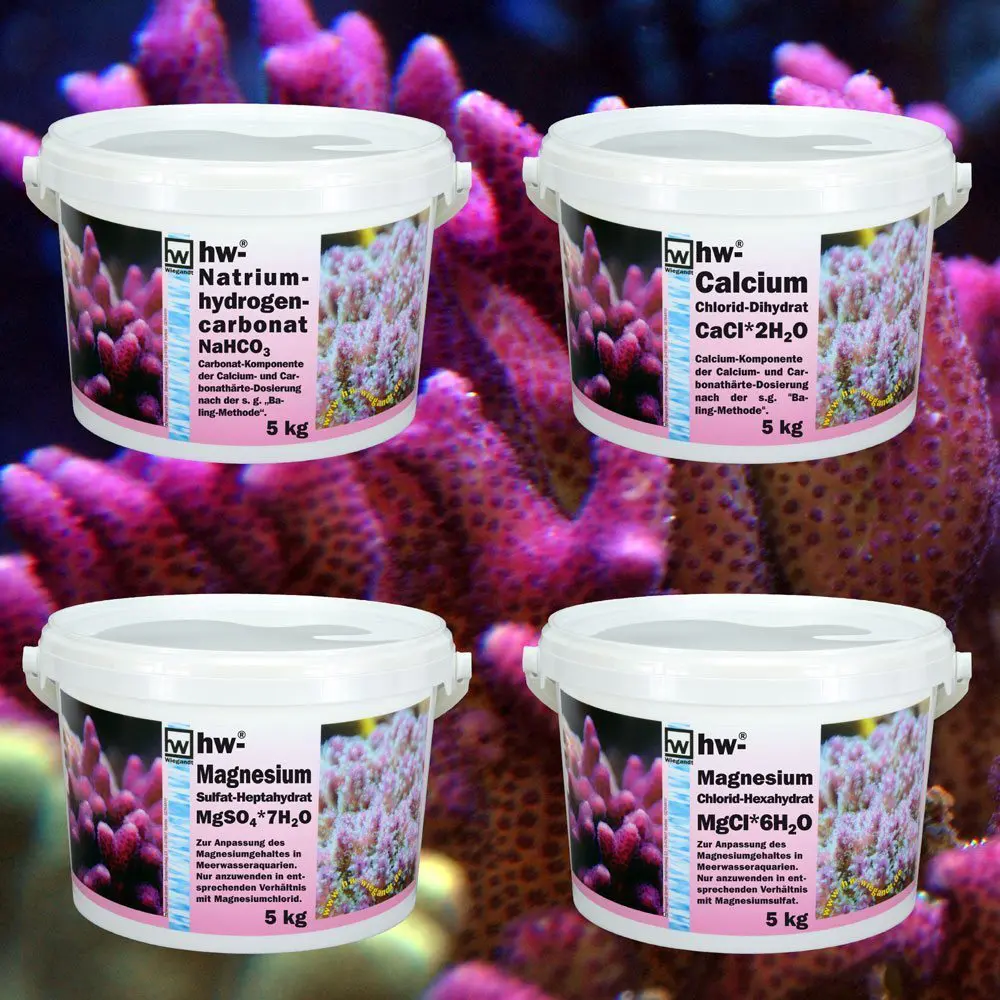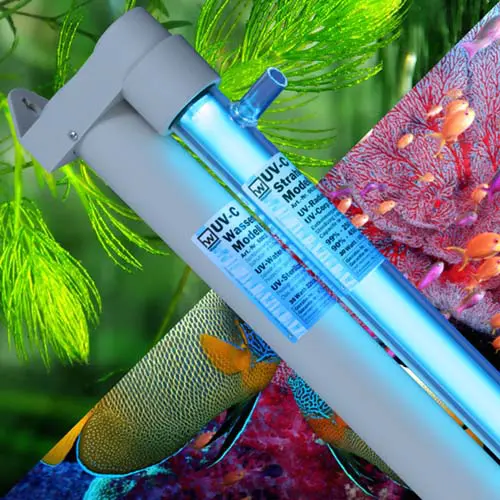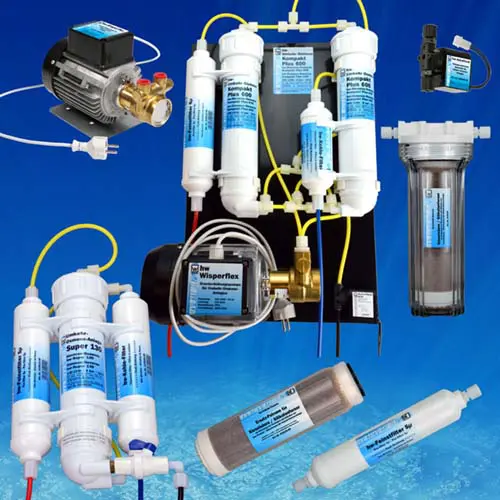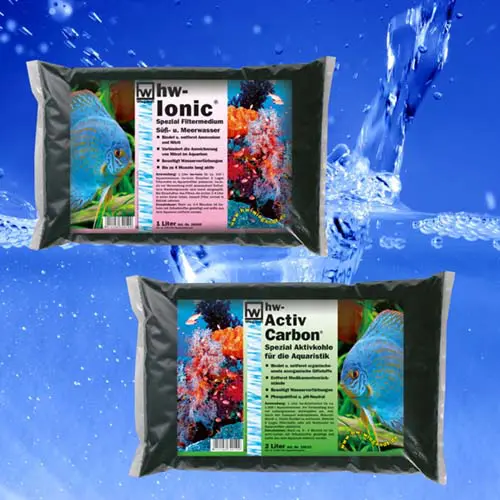hw®-Supplementing Salts
The hw®-Supplementing Salts makes it possible to specifically counteracts the taking place mineral consumption in closed environment of the marine aquarium. The elements which has to be most frequently supplemented are the alkaline earth ions like Calcium, Magnesium and there carbonate conjunctions as part of the carbonate alkalinity .
To be able to supplement especially this elements, without coming into the risk to cause unwanted displacements of the marine water ion balance, a special system has been created.
With this system remaining and redundant chloride and sodium ions, in the correct mass relation, results to NaCl or common salt.Taking in consideration that NaCl is one of the major elements of marine water it has to be found a way to compensate this steadily increase of the NaCl part. To be able to realize this the application of a NaCl „free“ marine salt mix is one of the best methods. The salinity will therefore slowly but steadily rise up but this can be easily compensated with the next water change by adding some more fresh water.
With the hw®-Supplementing Salts a basis is offered to realize the supplementing of this elements in accordance to the needs of your aquarium.
hw-Calciumchlorid-Dihydrat
(CaCl2 x 2H2O)
Calcium chloride in fine crystalline form, for the adaptation of water parameters
Pure Calcium chloride dihydrate (CaCl2 x 2H2O) in fine crystalline form for the increasing of the Calcium concentration in accordance to the Calcium chloride / Sodium hydrogen carbonate method.
Best practice:
By Appling this method Calcium and Carbonates where supplemented to the aquarium water, by adding hw®-Calciumchlorid (CaCl2) and hw®-Natriumhydrogencarbonat (NaHCO3). As excess components Cl (chloride) and Na (sodium) will remain and the end result is NaCl = salt. NaCl is one of the main components of natural marine water but a steadily increase of NaCl will lead to a negative change in the water composition.
To avoid such changes it is useful to compensate the increasing NaCl component by applying a NaCl „free“ marine salt (hw®-MineralMarin). By this way the end result will be again normal marine water, without changing the ion balance of the marine water.
Only side effect of this method is, that the density / salinity of the aquarium water will slowly increase. You can control this side effect by measuring the Density / specific gravity from time to time with a hw®-Densitometer with Thermometer.
If you notice an increasing of the measured value you can compensate this by just only adding a higher part of fresh water when making the next water change.
hw-Magnesiumchlorid-Hexahydrat
(MgCl2 x 6H2O)
Magnesiumchlorid in fine crystalline form, for the adaptation of water parameters
Pure Magnesium-chloride-hexahydrate(MgCl2 x 6H2O) in fine crystalline form for the increasing of the magnesiumconcentration in accordance to the Magnesium chloride / Sodiumhydrogencarbonat method.
Best practice:
By appling this method Magnesium and Carbonates where supplemented to the aquarium water, by adding hw®-Magnesiumchlorid (MgCl2*6H2O) and hw®-Natriumhydrogencarbonat (NaHCO3). As excess components Cl (chloride) and Na (sodium) will remain and the end result is NaCl = salt.
NaCl is one of the greatest components of natural marine water but a steadily increase of NaCl will lead to a negative change in the water composition.
To avoid such changes it is useful to compensate the increasing NaCl component by applying a NaCl „free“ marine salt (hw®-MineralMarin). By this way the end result will be again normal marine water, without changing the ion balance of the marine water.
Only side effect of this method is, that the density / salinity of the aquarium water will slowly increase. You can control this side effect by measuring the Density / specific gravity from time to time with a hw®-Densitometer with Thermometer.
If you notice an increasing of the measured value you can compensate this by just only adding a higher part of fresh water when making the next water change.
The main concept:
Beside sodium chloride, magnesium is the second biggest component of the natural marine salt. But compared to sodium chloride, the magnesium level in the aquarium water will slowly declaim due to the adsorption of several marine organisms (like corals, mollusks and other reef building organisms) and bio-chemical processes.
Therefore to avoid deficits in Magnesium the concentration of this element should be adjusted from time to time. In natural marine water the Magnesium concentration is around 1250 – 1380 mg/l and depends strongly from seasonal changes and geographic location.
To elevate specifically the Magnesium concentration in the aquarium water you will need hw®-Magnesiumchlorid-Hexahydrate and also a specified amount of hw®-Magnesiumsulfat-Heptahydrat, to not alter negatively the natural balance of the chloride- and sulfate ions in the your aquarium water.
Best practice:
The exact calculation of the needed quantities in gram has to be made by calculating with the molar mass and under consideration of the bounded crystal water together with the fixed relation of chloride to sulfate in natural marine water.
By using the combination of hw®-Magnesiumchlorid-Hexahydrate and hw®-Magnesiumsulfat-Heptahydrat the weight relations are as following:
0,95 g hw®-Magnesiumsulfat-Heptahydrat (MgSO4x7H2O)
7,58 g hw®-Magnesiumchlorid-Hexahydrate (MgCl2*6H2O)
_____________________________________________________
1,00 g Magnesium (Mg)
Sample calculation:
A marine aquarium with 500 l water volume has a Magnesium concentration of 1200 mg/l, the concentration should be elevated to 1300 mg/l.
To calculate the needed quantity of Mg in gram proceed as following:
1300 -1200 = 100 mg/l * 500 l (aquarium volume) = 50 g Mg in total
50 g x 0,95 g = 47,50 g hw®-Magnesiumsulfat-Heptahydrat (MgSO4x7H2O)
50 g x 7,58 g = 379,00 g hw®-Magnesiumchlorid-Hexahydrate (MgCl2*6H2O)
Both quantities should be solved together in around 600 ml RO-water (or demineralized water) and filled up to finally 1000ml.
From this solution should be added 100 ml daily over the next 10 days to the aquarium water. On the 5. day please realize a control measuring of the actual magnesium level/concentration in the aquarium water, so that eventually adaptation could be made.
hw-Natriumhydrogen-Carbonat
(NaHCO3)
Sodium bicarbonate fine powder form, for the adaptation of water parameters (Carbonathärte).
Pure sodium bicarbonate (NaHCO3) in the finest crystalline form.
- to elevate the carbonate hardness / alkalinity and calcium level according to the Calcium chloride / Sodium bicarbonate method.
- to elevate the carbonate hardness / alkalinity and the Magnesium concentration according to the Magnesium chloride / Sodium bicarbonate method.
Best practice:
Applying this method , calcium concentration and carbonate hardness would be increased by adding hw-Calciumchlorid(CaCl2) and hw-Natriumhydrogencarbonate (NaHCO3) to the aquarium water.
As side effect Cl (chloride) and Na (sodium) will remain and this both elements will result to NaCl which is simple salt.
So far the NaCl is one of the main compounds of marine water but a steadily raising concentration of NaCl would lead to a increasing adulteration of the marine water composition and can cause on long term major problems.
To avoid this changes in the water composition the missing elements should be added by using a certain quantity of a „NaCl-free“ marine salt formulation like hw®-MineralMarin. The end balance of all added elements will than result again in a complete marine water formulation with nearly no surplus of elements.
By applying this method over longer time the salinity / density of the aquarium water will raise slowly (or even faster) so that you should have always a eye on this values. If the salinity / density will raise too much you will have to counteract this with a smaller water change of fresh water.
Best practice:
Applying this method , the Magnesium concentration and carbonate hardness would be increased by adding hw®-Magnesiumchlorid-Hexahydrat (MgCl2 x 6H2O) and hw®-Natriumhydrogencarbonate (NaHCO3) would be added to the aquarium water.
As side effect Cl (chloride) and Na (sodium) will remain and this both elements will result to NaCl which is simple salt.
So far the NaCl is one of the main compounds of marine water but a steadily raising concentration of NaCl would lead to a increasing adulteration of the marine water composition and can cause on long term major problems.
To avoid this changes in the water composition the missing elements should be added by using a certain quantity of a „NaCl-free“ marine salt formulation like hw®-MineralMarin. The end balance of all added elements will than result again in a complete marine water formulation with nearly no surplus of elements.
By applying this method over longer time the salinity / density of the aquarium water will raise slowly (or even faster) so that you should have always a eye on this values. If the salinity / density will raise too much you will have to counteract this with a smaller water change of fresh water.
hw-Magnesiumsulfat-Heptahydrat
(MgSO4 x 7H2O)
Magnesium sulfate in fine crystalline form, for the adaptation of water parameters
Pure Magnesiumsulfat-Heptahydrat (MgSO4 x 7H2O) in fine crystalline form for the increasing of the Magnesium concentration in combination with hw®-Magnesiumchlorid-Hexahydrat.
The main concept:
Beside sodium chloride, magnesium is the second biggest component of the natural marine salt. But compared to sodium chloride, the magnesium level in the aquarium water will slowly declaim due to the adsorption of several marine organisms (like corals, mollusks and other reef building organisms) and bio-chemical processes.
Therefore to avoid deficits in Magnesium the concentration of this element should be adjusted from time to time. In natural marine water the Magnesium concentration is around 1250 – 1380 mg/l and depends strongly from seasonal changes and geographic location.
To elevate specifically the Magnesium concentration in the aquarium water you will need hw®-Magnesiumchlorid-Hexahydrate and also a specified amount of hw®-Magnesiumsulfat-Heptahydrat, to not alter negatively the natural balance of the chloride- and sulfate ions in the your aquarium water.
Best practice:
The exact calculation of the needed quantities in gram has to be made by calculating with the molar mass and under consideration of the bounded crystal water together with the fixed relation of chloride to sulfate in natural marine water.
By using the combination of hw®-Magnesiumchlorid-Hexahydrate and hw®-Magnesiumsulfat-Heptahydrat the weight relations are as following:
0,95 g hw®-Magnesiumsulfat-Heptahydrat (MgSO4x7H2O)
7,58 g hw®-Magnesiumchlorid-Hexahydrate (MgCl2*6H2O)
_____________________________________________________
1,00 g Magnesium (Mg)
Sample calculation:
A marine aquarium with 500 l water volume has a Magnesium concentration of 1200 mg/l, the concentration should be elevated to 1300 mg/l.
To calculate the needed quantity of Mg in gram proceed as following:
1300 -1200 = 100 mg/l * 500 l (aquarium volume) = 50 g Mg in total
50 g x 0,95 g = 47,50 g hw®-Magnesiumsulfat-Heptahydrat (MgSO4x7H2O)
50 g x 7,58 g = 379,00 g hw®-Magnesiumchlorid-Hexahydrate (MgCl2*6H2O)
Both quantities should be solved together in around 600 ml RO-water (or demineralized water) and filled up to finally 1000ml.
From this solution should be added 100 ml daily over the next 10 days to the aquarium water. On the 5. day please realize a control measuring of the actual magnesium level/concentration in the aquarium water, so that eventually adaptation could be made.

tips & hints
Follow up instruction for setting up of solutions and usage of the supplement salts according to the different methods.
Application according to the so called „Balling-Method“:
If the so called „Balling-Method“ is applied, calcium concentration and carbonate hardness would be increased by adding hw-Calciumchlorid(CaCl2) and hw-Natriumhydrogencarbonate (NaHCO3) would be added to the aquarium water.
As side effect Cl (chloride) and Na (sodium) will remain and this both elements will result to NaCl which is simple salt.
So far the NaCl is one of the main compounds of marine water but a steadily raising concentration of NaCl would lead to a increasing adulteration of the marine water composition and can cause on long term major problems.
To avoid this changes in the water composition the missing elements should be added by using a certain quantity of a „NaCl-free“ marine salt formulation like hw®-MineralMarin. The end balance of all added elements will than result again in a complete marine water formulation with nearly no surplus of elements.
By applying the „Baling-Method“ over longer time the salinity / density of the aquarium water will raise slowly (or even faster) so that you should have always a eye on this values. If the salinity / density will raise too much you will have to counteract this with a smaller water change of fresh water.
Way of proceeding:
The best would be to prepare 3 solutions of 2 liters each. To prepare the solutions please only use RO-water o demineralized water as to avoid precipitations cause by minerals present in normal tap water.
- Canister I with 213,50g hw-Calciumchlorid-Dihydrat per 2 l RO o demineralized water
- Canister II with 163,80g hw-Natriumhydrogencarbonat per 2 l RO o demineralized water
- Canister III with 48,75g hw-MineralMarin per 2 l RO o demineralized water
Application of the prepared solutions:
Take in consideration that the elevation of the Calcium concentration of 50 mg/l will simultaneously provoke a raise of the carbonate hardness of about 7° dKH!
When starting with the dosing, the solution should applied with 5 ml / ccm per 10 liters of aquarium water. A daily control measuring of the calcium and carbonate hardness should be made to get a feeling for the effect of the dosing.
In any case both values should only be raised slowly!
If the proposed values are reached, the dosing should be reduced or elevated by 10% till the values stabilized at the desired point. If one time the optimal dosing for the aquarium has been found a weekly control measurement of the value should be enough.
But please be aware that due to seasonal influences (temperature, light incidence, etc.) and also through changes in the aquarium (coral growth, new animals, reducing of the live stock, etc.) fluctuations can happened which will make it necessary to adapt or recalibrate the dosing to compensate them.
Application according to the so called „Balling-Method“:
The main principle is nearly the same like followed in the Calcium-Version of this method. The difference is that in the Can No. 1 now Magnesium chloride is solved instead of Calcium chloride.
- Canister I with 199,20g hw®-Magnesiumchlorid-Hexahydrate (MgCl2*6H2O) per 2 l RO / demineralized water
- Canister II with 163,80g hw®-Natriumhydrogencarbonat per 2 l RO / demineralized water
- Canister III with 48,75g hw®-MineralMarin per 2 l RO / demineralized water
The approach of dosing is nearly the same like with Calcium-Version. Please tke in mind that the consumption of Magnesium in a marine aquarium is considerable lower than the Calcium consumption. Therefore it is mostly totally sufficient to adapt the Magnesium level ones, if it was detected to be too low.
A measurable decline of the Magnesium concentration cold be reported eventually only after several weeks or month.
Please observe that the Magnesium concentration did not rise to high!
Magnesium concentration above 1600 mg/l will stress many marine live forms und can only be lowered through repeated and bigger water changes to a normal concentration (1250 to 1380 mg/Liter).

All supplementing salts
You’re looking for additional products related to this topic? All products you will find in our product catalog.





